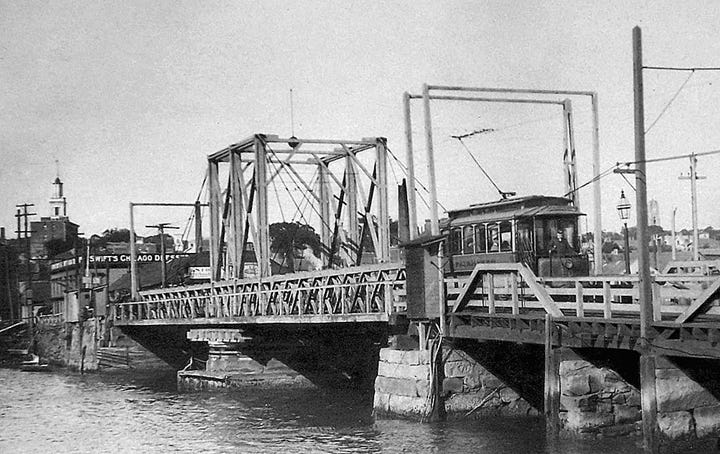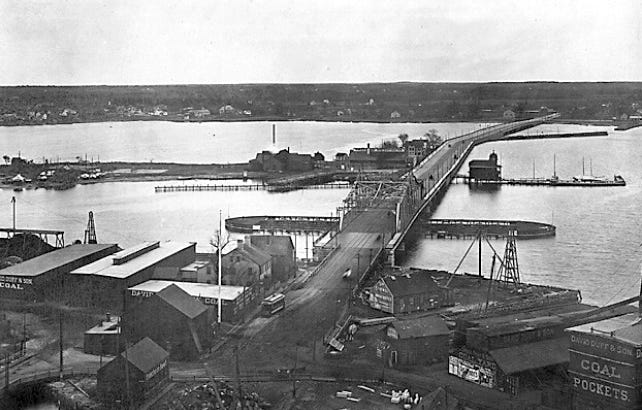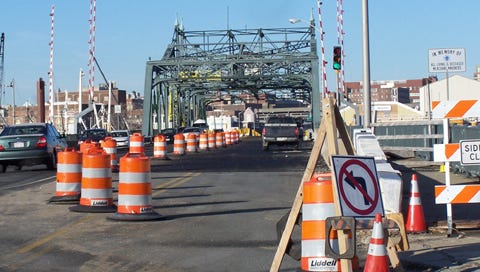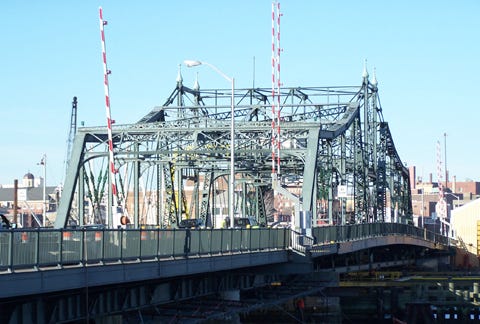For more than two-hundred and twenty years now, the Fairhaven-New Bedford Bridge has linked the east and west shores of the Acushnet River. And for about the same length of time, the span has been both a blessing and a curse. What follows is a chronology highlighting the history of the bridge and its impact on our harbor.
1790s
The only public means of crossing the Acushnet River is one sailing ferry. Private transportation includes sailing or rowing across or traveling north to Head of the River (Acushnet Village) and crossing on the bridge there.
1796
A group of businessmen headed by William Rotch Jr. is granted permission to construct a toll bridge. The owners of Fish Island and Pope’s Island grant the bridge proprietors the right of way to cross their properties.
The bridge is built with two draws which can open to allow passage of boat traffic. One is west of Fish Island and the second is between Pope’s Island and Fairhaven. Bridge Street is laid out, connecting to Main Street about midway between the villages of Fairhaven and Oxford

1801
The Fairhaven-New Bedford Bridge opens to travel. It is 4,500 feet long with a 21-foot wide road and a 5-foot sidewalk. It cost about $30,000 to build.
March 1807
A storm with an exceptionally high tide sweeps away much of the wooden structure of the bridge. It takes about six months to rebuild at a cost of approximately $8,000.
September 23, 1815
A fierce gale demolishes the bridge a second time. It is left in disrepair for some time.
The bridge is finally rebuilt using a sturdy foundation of rubble stone. This shifts and slows the river currents, causing areas to the north of the bridge—particularly around Oxford Village—to silt up and become too shallow for many vessels. According to a resident of Oxford the bridge “completely ruined the business of the place.” This loss of business due to the damage done by the bridge is considered to be the origin of Oxford Village’s nickname “Poverty Point.”
November 5, 1819
The reopening of the bridge is announced.
1848
Some of the tolls charged for crossing the bridge are: 2¢ for crossing on foot or 100 tickets for $1.00, 3¢ for wheelbarrow or hand cart, 12 ½¢ for horse and rider, single horse with cart, wagon, sleigh, etc., 20¢ for riding carriages with 2 horses. The tolls are lower than those originally collected.
mid-1850s
The draw at Fish Island is widened to allow larger vessels to pass north of the bridge. Despite the improvement, Daniel Ricketson writes, “the bridge is still thought by many to be a great public damage. . . . the value of our harbor and the property above the bridge, as well as the beauty of the river, is much impaired by it.”
1861
A year after Weston Howland began refining petroleum on the south side of Fish Island, his refinery is destroyed by an explosion that kills two men. Howland rebuilds.
1867
Petitions for eliminating tolls and making the bridge a free public way are begun.
1869
The call for a free bridge is continued. It is reported that $5,000 to $6,000 a year is collected in tolls.
September 8, 1869
The Great Gale of 1869 brings tides more than eleven feet higher than normal. The bridge is severely damaged again.
October 27, 1869
The state legislature declares the Fairhaven-New Bedford Bridge a free public way, paying the proprietors about $21,000.
June 1870
The repaired bridge is reopened as a free bridge. It is later reported that the elimination of the tolls has resulted in the rental of virtually all of the available tenements in Fairhaven.
September 30, 1872
Horse car service to and from New Bedford via the bridge is begun by the New Bedford & Fairhaven Street Railway Company, which has been founded earlier in the year. The service operates half-hourly.
1877
The New Bedford Yacht Club is founded and has its first clubhouse on Fish Island.
Nye Oil Works moves into the three-story stone factory building on the south side of Fish Island which had been owned by Weston Howland.
1879
The New Bedford Yacht Club builds a new 2½-story Victorian style clubhouse on pilings off the south side of Pope’s Island.
1887
David Duff and Son Coal Company buys out the Parker and Haskell Coal Company on Fish Island. Duff nearly doubles the area of the island by filling.
1890
The Union Street Railway begins replacing horse cars with electric trolleys. Fairhaven votes not to allow electric cars into town, so the electric cars run only as far east as Pope’s Island.
1892
The new Coggeshall Street Bridge opens to traffic in North Fairhaven.
1893
The construction of a new Fairhaven-New Bedford Bridge is approved by the state. $350,000 is allocated for the project.
June 7, 1894
Henry H. Rogers writes to County Commissioner William Sanders, urging the commissioners to locate the Fairhaven entrance of the new bridge about 300 feet north of Bridge Street, primarily because it would allow a wide and straight road to be run through unimproved property, which could be made more attractive and possibly stimulate new development. Fairhaven residents to the south of the bridge prefer the old entrance at Bridge Street, while residents to the north tend to favor the new proposal.
Rogers also feels that the roadway at the New Bedford end should be raised over the railroad tracks instead of entering at grade level as the old bridge does.
Ultimately the plan Rogers favors is adopted.
1895
Electric trolleys are allowed to cross the bridge into Fairhaven.
The state increases the allocation for the construction of the new bridge to $450,000.
1896
Construction of the new bridge is begun. Work starts at the Fairhaven end.
1898
The state again increases the allocation for the bridge, this time to $800,000.
In September, the hydraulic draw mechanism is installed between Pope’s Island and Fish Island. West of Fish Island, the road level is raised to pass over the railroad tracks.
June 8-29, 1901
A 14½ foot high drinking fountain topped with a “Water Nymph” statue is installed in the center of Huttleston Avenue at the new bridge entrance by the Fairhaven Improvement Association. Its octagonal base has projecting basins “for the use of People, horses, and dogs.”
1902
The new bridge, built at a cost of $1.4 million, opens to traffic. Also this year the Pope’s Island Car Barn of the Union Street Railway Company is built.
November 20, 1909
It is announced that after years of poor service due to insufficient water flow, the Improvement Association fountain at Main Street and Huttleston Avenue has been sold. It is not replaced.

November 29, 1922
Construction is completed on a bulkhead on the south side of Pope’s Island, which is to be filled to create a public park.
1926
The New Bedford City Engineer reports that nearly seven acres of filled land has been created on the south side of Pope’s Island, some of which has been graded to the level of the road. The east seawall of the newly created land is the old foundation of the original bridge to Bridge St.
1927
It is reported that the filled bulkhead on Pope’s Island is ready to turn over to the New Bedford Park Board. The City Engineer writes, “The land for this park, consisting almost wholly of riparian rights below high tide, was given to the city by the Union Street Railway company and by the heirs of Samuel P. Pope with the stipulation that it should always be used for park purposes.” It is known as Marine Park.
1930
The Commonwealth of Massachusetts assumes control of the bridge, which soon is part of the new U.S. Route 6.
In the spring, Nye Oil Company moves from Fish Island to a new factory on Howland Road in North Fairhaven. The Fish Island property is purchased by Standard Oil.
September 21, 1938
The Great New England Hurricane of 1938 completely destroys the New Bedford Yacht Club and much of the old Nye Oil facility. Salt water floods the Car Barn on Popes Island damaging some of the trolleys stored there.
1947
In this year, automobile traffic on the bridge is given precedence over marine traffic.
mid-1950s
The bridge is called New Bedford’s biggest traffic problem.
1958
David Duff and Sons Coal and Oil Company on Fish Island becomes Glen Coal and Oil Inc. Also this year, the Exchange Club of New Bedford and the New Bedford Seafood Council holds the first three-day Scallop Festival under a large tent at Marine Park on Pope’s Island.
1965
Frionor Norwegian Frozen Fish Ltd. moves to New Bedford, building a processing plant just north of the bridge.
1975
The construction of the John F. Kennedy Highway (Route 18) results in a major modification to the New Bedford end of the bridge. Part of New Bedford’s Middle Street and the Bridge Park are eliminated. The “octopus” intersection at Pleasant Street is created.
June 1979
After years of complaints about bridge breakdowns and traffic problems, Gov. Edward J. King announces a new Fairhaven-New Bedford Bridge will be built. This is designed by the state DPW, but concern over PCB pollution in the harbor stalls construction plans.
1984
The state spends $211,756 to replace the bridge’s hydraulic system.
December 1987
The state finally decides not to build a new bridge but to overhaul the existing one.
July 1988
The bridge breaks down five times in one week.
January-February 1989
The bridge is closed 6 weeks for repairs.
1993
The City of New Bedford opens the Pope’s Island Marina.
October 1994
Kiewit Construction Co. of Medway, MA, is the low bidder for the approximately $16 million bridge rehabilitation project.
May 15, 1995
The bridge is closed for major repairs. It is estimated that it should be out of service for about 6 months. The project ends up taking eleven months.
April 15, 1996
At a brief ceremony at noon, the repaired bridge is reopened to traffic.
April 1996
The town’s new Master Plan reports an Average Daily Vehicle Count of 20,000 on Route 6 at the bridge.
May 3, 1996
Only 18 days after reopening, the bridge is closed following the breakdown of its two gear reduction units.
May 26, 1996
The bridge is reopened using a temporary crane and winch system to open and close it while its two transmission systems are being repaired.
And today
As this is being written in the winter of 2024, bridge repairs are still ongoing, as they have been for 222 years and new plans for replacing the New Bedford-Fairhaven Bridge are in the review process.
© 2004, 2024 by Christopher J. Richard. All rights Reserved. This article was slightly updated from the original published in Fairhaven’s Monthly Navigator in 2004.







Thanks for the thorough history on this bridge. My brother Tony once worked there, handling the controls that would enable boats to pass through. "Open the bridge, Tony."